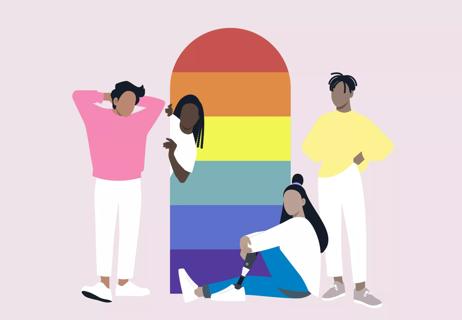Our understanding of what it means to be asexual has blossomed

Within the spectrums of sexual orientations and gender identities, there exists a wide, wonderful world of identities to discover. Knowing who you are and how you identify can come easily for some. But for others, it can be a lifelong journey of discovery based on personal experiences and development.
Advertisement
Cleveland Clinic is a non-profit academic medical center. Advertising on our site helps support our mission. We do not endorse non-Cleveland Clinic products or services. Policy
As our language around identity continues to evolve, so, too, has our ability to create more terminology that better defines how we feel about who we are, who we’re attracted to and how we experience attraction. This is especially true for the asexual community.
Over the last decade, our understanding of what it means to be asexual has blossomed, giving rise to a multitude of identities that are defined by the ebb and flow of our own sexual attraction and how it relates to our relationships, sexual desire and romantic attraction. Our understanding of the different identities we all have is crucial to the mental health, emotional health and overall well-being of ourselves, our friends, our families and the members of our community. This is important when you consider that, historically, medical education has excluded LGBTQIA+ health-related content from curricula as a result of discrimination.
“Asexuality is a little nebulous,” says pediatric psychologist Gina Rhodes, PhD. “Asexuality is on its own spectrum and it’s looking at not just sexual attraction, but also romantic attraction.”
Dr. Rhodes helps us explore what it means to be asexual, while paying special attention to the ways we talk about attraction across the board.
Advertisement
Also referred to as “ace,” asexuality is an umbrella term for anyone who experiences little to no sexual attraction toward other people of any gender. Asexuality can vary in a lot of ways depending on our relationships and how we define our levels of sexual attraction, romantic attraction and aesthetic attraction.
It’s important to note that sexual attraction and romantic attraction are two different things; although, in modern society, they’re often blended together as two parts of the same whole.
Sexual attraction can be defined as our desire to touch another person in an intimate way. We can be sexually attracted to someone without ever experiencing romantic feelings.
Romantic attraction, then, can be defined as our desire to have a deep, affectionate connection with someone else. Romantic attraction can exist without us ever experiencing sexual attraction and it relies solely on establishing that close, emotional attachment. You can be aromantic, which means you may experience little to no romantic attraction to other people of any gender.
Then, there’s aesthetic attraction, which can be defined as appreciation for someone’s beauty or appearance without having sexual or romantic attraction.
For people who identify as asexual, they may experience heightened levels of romantic or aesthetic attraction, but little to no sexual attraction to the people in their lives.
“It looks different from person to person,” says Dr. Rhodes. “For some people, it means they have a romantic partner but perhaps that relationship either doesn’t include sexual contact or includes different kinds of intimate contact like cuddling. Or, it could involve sexual contact but it’s just not something that the asexual partner feels strongly about.”
Someone who identifies as asexual might engage in sex as more of a way to show that they care, for example, rather than something they’re invested in.
There are a lot of misconceptions about asexuality. It’s often been wrongly confused with loss of libido. One major misconception is that asexuality is a medical condition on its own that can be cured or treated. Others like to think asexuality is like celibacy or abstinence. And then there’s the dangerous presumption that someone might identify as asexual because they’ve experienced some kind of sexual trauma or physical assault. But Dr. Rhodes warns that these misconceptions are generally untrue and can be quite harmful.
Advertisement
“Associating asexuality with trauma does get harmful because, for many people, this is something that’s been a process of discovery rather than something that was inflicted upon them,” says Dr. Rhodes. “The assumption that someone’s identity is a result of trauma can really take away the agency and hard work that person may have done to accept themselves for being asexual, especially when we live in a society that really values sexual and romantic attraction.”
And unlike celibacy or abstinence — which are temporary decisions based on one’s circumstances or beliefs — asexuality is an orientation, an identity and a state of being. It’s not a choice.
“Asexuality is something more persistent,” says Dr. Rhodes.
Like all sexual orientations that exist on a spectrum, asexuality can be fluid. Someone who is asexual may experience varying degrees of sexual attraction throughout their lifetime and it can vary from relationship to relationship. Someone may use the umbrella term “asexual” as their defining identity. There are also several subgroups or categories of identities that have been created to better define the various degrees someone might experience their asexual identity.
The following list is not all-inclusive, but these are some asexual identities to be aware of:
Advertisement
As a sexual orientation on the asexual spectrum, this identity is defined as someone whose orientation changes over time but generally stays on the asexual spectrum. For example, if you usually have no desire for sexual activity, but there are days or weeks where you do desire sexual activity, this might be an identity you relate to.
“Asexuality can change over time as people know themselves better and get a better picture of what relationships look like,” says Dr. Rhodes. “It’s something that can be in flux for a lot of people.”
If you’re demisexual, you may only find someone sexually attractive if you’ve developed an emotional or romantic connection with them. If you don’t have that emotional or romantic connection, you typically don’t experience sexual attraction to others. For many people who identify as demisexual, they may hold off on participating in sexual activity until they’ve developed that emotional and romantic connection.
Someone who is fraysexual (or ignotasexual) may experience sexual attraction with someone at first, but then that sexual attraction fades over time once they develop an emotional bond. This identity can be seen as the opposite of demisexual.
As asexuality is a spectrum, graysexuals fall into that gray area that exists between wanting and not wanting sexual activity. You may identify as graysexual if you experience limited sexual attraction on an infrequent basis. When you do experience sexual attraction, it may not be strong or intense enough to act upon it.
Advertisement
This sexual orientation refers to people who may experience sexual attraction to others but don’t want those feelings reciprocated. You may be uncomfortable at the thought of someone finding you sexually attractive and you may lose your feelings of sexual attraction if you discover those feelings are mutual. For these reasons, you may not seek out sexual relationships.
Discovering your identity begins with reflecting on your own personal experiences and feelings. As you learn along the way, some important questions you may want to ask yourself include:
“A lot of people will begin this journey by just trying to learn more about asexuality and trying to get a sense of what label feels right for them,” says Dr. Rhodes. “The advice I would give is to make connections with other asexual people and asexual groups and hear about their experiences coming to terms with their identity. One of the best ways we can learn about ourselves is through other people’s journeys.”
If you’ve discovered that you’re asexual, when and how you share that information with the people in your life is up to you. How you choose to come out depends on how you’re feeling about your physical safety and emotional and mental health. Coming out happens at different times for different people, so it’s OK if you’re not ready.
When you are ready to share this information, though, a good place to start the conversation may be by asking your audience what they understand about asexuality.
“Start with what they already know,” advises Dr. Rhodes. “Ask, ‘What do you know about asexuality or the asexuality spectrum? What do you think of this idea that there’s a split between romantic and sexual attraction and how each of those things can vary from person to person?’”
By opening the conversation up in this way, you can gauge how much they know and where they could use more education to better understand your own identity. Along the way, your identity may change or evolve based on how you’re feeling and the kinds of relationships you’re a part of. If this happens, it’s important to remember, and remind your loved ones, that sexual orientation and asexuality exist on a spectrum. Who you are today may not be who you are tomorrow, and that’s perfectly OK.
“Identity is not a gotcha game. If someone’s identity changes or flexes, it’s influenced by their experience,” explains Dr. Rhodes. “When people tell you who they are, it’s valuable to believe them.”
Learn more about our editorial process.
Advertisement

‘Safer sex’ means STI prevention, avoiding unintended pregnancies and psychologically safe practices for everyone

Being nonbinary means not identifying solely (or at all) with being male or female

Start with one person you trust, and then you can open the door to the rest of the world

988 updates and replaces the old suicide hotline

The vagina is full of healthy and unhealthy bacteria, so discharge can be normal or problematic

Find a healthcare provider who’s welcoming and affirming

It can be difficult to qualify for certain tests

Contributing factors include racial disparities, high barriers to care and more

Type 2 diabetes isn’t inevitable with these dietary changes

Applying a hot or cold compress can help with pain